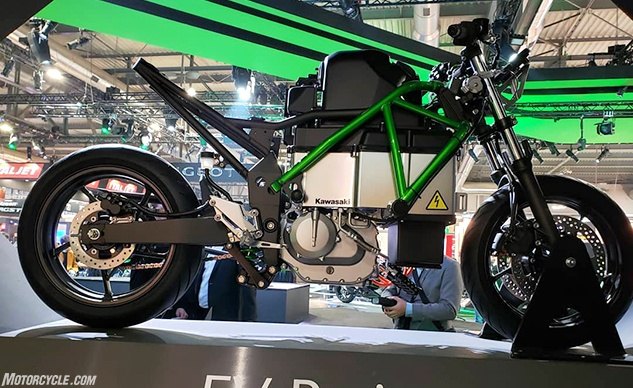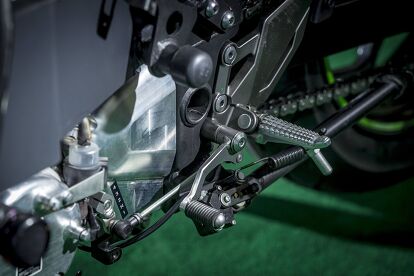Kawasaki Releases Details on Electric Motorcycle Concept

Last week, Kawasaki presented an electric motorcycle concept at EICMA, but did no reveal many details about it during the show. Today, Kawasaki finally released more information, confirming that the company has been researching electric vehicles for quite some time, including testing both on a race track and in urban environments. Unfortunately, Kawasaki says it remains purely a research project with no plans of releasing an electric motorcycle in the near future.
The test bike is a middleweight sized similar to a Ninja 650 with a trellis frame and typical streetbike suspension, and notably, a clutch and four-speed manual transmission.
Combining an electric motor with manual shifting was an important focus of the project, Yuji Horiuchi, president of Kawasaki Heavy Industries Motorcycle and Engine Company, said at EICMA.
“We have focused on the riding sensation during road testing combining electric power source – which enables high level of flexibility in torque/power delivery – with gear-shifting capability,” said Horiuchi. “The result is a machine delivering good rider feeling in line with our overall mission of Rideology. Rest assured though, we are finding many more avenues to explore to expand the excitement of control on two wheels.”
While manual shifting may have been a major aim of the project, Kawasaki can’t say the same about the electric powertrain’s performance. Kawasaki says the electric motorcycle produces the equivalent of 27 hp during acceleration and a cruising output equivalent to 13.5 hp. By comparison, the Ninja 650 claims a peak output of about 67 hp. At a claimed weight of 483 pounds, the electric bike is also heavier than the Ninja 650’s claimed curb weight of 423 pounds (with ABS).
We assume most of that weight is in the battery which is powered up with a CHAdeMo-style charging system or a 100-240V domestic power supply. Kawasaki says the battery can provide a range of 100 km (about 62 miles) on a full charge. Another feature, which you can see in action at the 1:11 mark of the video above, is a lever located below the left handlebar that activates the regenerative braking system.
Until now, Kawasaki has been relatively quiet about electric motorcycles, especially among the Big Four Japanese manufacturers. Honda, Yamaha and even Suzuki, have shown at least concepts if not production electric two-wheelers. However, we know from various patent filings that Kawasaki has been working on several designs over the years, including several credited to Yoshimoto Matsuda, the senior manager of innovation featured in the video above. These patents included illustrations that showed some vastly different designs, including some with manual transmissions.
The bike shown at EICMA looks particularly similar to the illustrations from a patent filed in Japan in 2010 (and later filed in the U.S. in 2013). This patent described a method to make the battery pack easily detachable. Though it may look like the concept uses a single-piece trellis frame, on closer inspection you can see there are actually separate left and right side frames that bolt onto a headstock assembly. This allows for the quick removable or installation of the battery by unbolting one side.
Kawasaki has explicitly said it has no plans to add an electric motorcycle to its lineup in the near future, and that might be due to the current limitations of the technology. Kawasaki’s approach seems to be to focus on other aspects of electric motorcycle design which could put them in position to move quickly once the technology has reached a satisfactory level for mass production.

Dennis has been a part of the Motorcycle.com team since 2008, and through his tenure, has developed a firm grasp of industry trends, and a solid sense of what's to come. A bloodhound when it comes to tracking information on new motorcycles, if there's a new model on the horizon, you'll probably hear about it from him first.
More by Dennis Chung
















































Comments
Join the conversation
Orange high voltage cables at the lowest point of the motorcycle, right behind the front wheel? What could go wrong?
Kaw needs to read MO, specifically the article about the Lightfighter LFR19. Now that is an electric motorcycle.
https://www.motorcycle.com/...